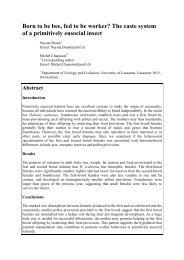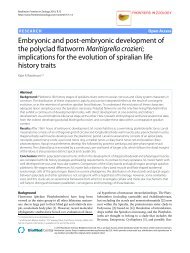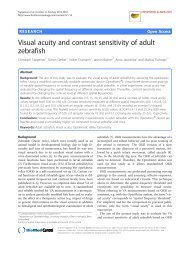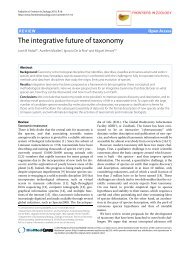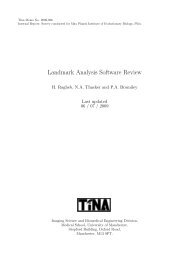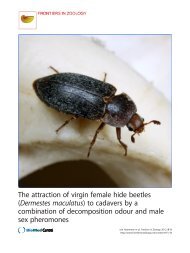Provisional PDF - Frontiers in Zoology
Provisional PDF - Frontiers in Zoology
Provisional PDF - Frontiers in Zoology
Create successful ePaper yourself
Turn your PDF publications into a flip-book with our unique Google optimized e-Paper software.
Menzel et al. <strong>Frontiers</strong> <strong>in</strong> <strong>Zoology</strong> 2013, 10:32 Page 6 of 12<br />
http://www.frontiers<strong>in</strong>zoology.com/content/10/1/32<br />
aggression <strong>in</strong>dex<br />
1.0<br />
0.8<br />
0.6<br />
0.4<br />
0.2<br />
0.0<br />
hydrocarbons +<br />
crematoenones<br />
Crematogaster species studied so far possess a peculiar<br />
system of venom production: precursors from Dufour’s<br />
gland are derivatized by enzymes from the poison<br />
gland [21,24]. It may be due to this mechanism that<br />
Crematogaster species produce such chemically diverse<br />
venoms. While several of the previously described<br />
Crematogaster venoms are derived from either fatty acid or<br />
terpenoid metabolism, other ant venoms studied so far are<br />
often alkaloids and are probably derived from the am<strong>in</strong>o<br />
acid, polyacetate, or fatty acid metabolism [25].<br />
We propose that the biosynthesis of crematoenones<br />
can be l<strong>in</strong>ked to a polyketide-type biosynthesis pathway.<br />
A proposed polyketide of 11 acetate units, re-arranged<br />
by two <strong>in</strong>tramolecular aldol condensations (f<strong>in</strong>ally<br />
form<strong>in</strong>g the octahydronaphthalene r<strong>in</strong>g system) followed<br />
by several modifications <strong>in</strong>clud<strong>in</strong>g decarboxylation,<br />
elim<strong>in</strong>ations of water (result<strong>in</strong>g <strong>in</strong> double bonds) and<br />
multiple reductions could expla<strong>in</strong> the formation of the<br />
C21-backbone of crematoenones. Biosynthesis based on<br />
a C21-hydrocarbon is an alternative pathway, but it<br />
seems less likely. Notably, the crematoenones seem<br />
to be synthesized de novo, s<strong>in</strong>ce their composition<br />
rema<strong>in</strong>ed constant <strong>in</strong> colonies that were kept <strong>in</strong> the laboratory<br />
on an artificial diet of dead <strong>in</strong>sects, honey, and<br />
Bhatkar diet for up to 15 months [10]. This contrasts<br />
with e.g. herbivorous beetles, which take up tox<strong>in</strong>s from<br />
their host plants with few if any modifications [25],<br />
although a fungal or microbial orig<strong>in</strong> of crematoenones<br />
cannot be ruled out.<br />
Cr. difformis Cr. coriaria allocolonial control<br />
Cr. modiglianii<br />
dead ant<br />
hydrocarbons<br />
dead ant<br />
Figure 4 Effect of crematoenone addition on aggression of Camponotus rufifemur (colony B1). Dead ants, cuticular hydrocarbons, and<br />
cuticular hydrocarbons mixed with allocolonial Cr. modiglianii crematoenones were tested. For Cr. coriaria, cuticular extracts only conta<strong>in</strong>ed<br />
hydrocarbons but no other substances. Each plot represents 10 replicates. The third and the forth panel conta<strong>in</strong>s data also shown <strong>in</strong> Figure 3a.<br />
total extract<br />
total extract +<br />
crematoenones<br />
dead ant<br />
hydrocarbons<br />
hydrocabons +<br />
crematoenones<br />
hexane<br />
Interspecific nestmate recognition is mediated by<br />
hydrocarbons<br />
Among the seven colonies that were chemically<br />
characterized, we found a total of 24 different novel<br />
compounds. Although Cr. modiglianii exhibits colonyspecific<br />
crematoenone profiles, neither of the two species<br />
differentiated between <strong>in</strong>tra- and allocolonial<br />
crematoenones, but clearly discrim<strong>in</strong>ated <strong>in</strong>tracolonial<br />
from allocolonial hydrocarbons of the respective partner<br />
species. Our experiments hence show that the recognition<br />
of the partner species (though not necessarily<br />
the partner colony) is mediated by cuticular hydrocarbons<br />
like it is known from other ant species [26], and<br />
not the crematoenones.<br />
Interest<strong>in</strong>gly, the relative composition varied strongly<br />
among Cr. modiglianii colonies (Additional file 1: Table<br />
S1, [13]), and this variance rema<strong>in</strong>ed constant <strong>in</strong> wild<br />
and captive colonies [10]. The crematoenone profile<br />
might hence be highly genetically determ<strong>in</strong>ed. However,<br />
s<strong>in</strong>ce nestmate recognition is mediated through cuticular<br />
hydrocarbons (which are highly similar among the Cr.<br />
modiglianii colonies studied, [10,13]), they may also<br />
serve as sex pheromones like <strong>in</strong> many solitary <strong>in</strong>sects<br />
[27,28]. Thus, differ<strong>in</strong>g crematoenone profiles should<br />
not lead to reproductive isolation. In prelim<strong>in</strong>ary analyses,<br />
we did not f<strong>in</strong>d genetic differentiation between Cr.<br />
modiglianii colonies accord<strong>in</strong>g to crematoenone profile<br />
(FM unpublished data), provid<strong>in</strong>g no evidence for cryptic<br />
species <strong>in</strong> Cr. modiglianii.




